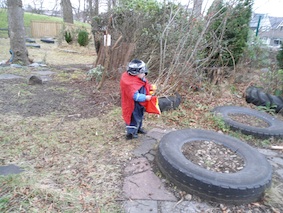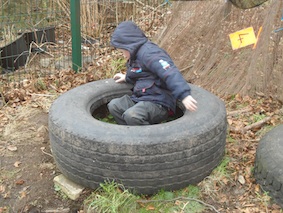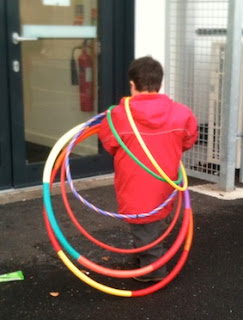One of many advantages of repeated visits to a place is the development of an affinity or connection with it. Familiarity provides security amidst change and chaos.
Since October, two of my classes have been visiting a unique and remarkable place. It’s in the spacious school grounds. It’s old and worn. It’s much loved. It’s known as the wildlife garden, yet there’s few native species and, in reality, its value for my classes is as a play space of exploration, discovery and challenge.
One of its key features is the log in the photo below. This is the original rite of passage. At some point most children have to try climbing onto it and walking along it. Often this begins with a request for adults to assist.

However, progress can be seen when the children start supporting each other, unasked but in shared appreciation of the challenge ahead.
There is something inherently satisfying about reaching the end and jumping off. For me, this log is an indicator of children’s confidence about height and balance.
This log also tells the history of this place. The original garden was created forty years ago and this log is the reminder of this legacy. It remains strong and resistant to rotting.

The other fallen down log is popular for different reasons. It really is decaying and crumbly. It’s more interesting to hit with a stick or examine with a fresnel lens.

Throughout the area, there are nooks and crannies allowing children a degree of privacy and space to be alone. This is so important. The school has 22 classes, an 80-place nursery and over 500 children. Solitude is rare, especially as the school is sited close to a big, busy hospital and dual carriageway. It’s a very urban site.

The nooks, crannies and dens also create a feeling of much more space than there is in reality. They help add a wildness and preciousness. There is almost always a child in this shrub-space:

It really is a den where children rule. Adults occasionally are taken there as a prisoner. Or because they’ve done something “bad”. Hats help with the role play. Below a child is wearing the popular “hoop hat” with lots of rings on it!

In one area, some older children created a den with an old camo net. It has been left out as part of my experiment to see if after-hours visitors or wildlife will remove or damage it. Two months on and all is well!

Behind the superhero in the photo below is this camo den which is definitely well camouflaged!

Owing to the mature beech trees, there is a supply of leaves that has lasted the whole winter. Several children make a point of visiting the leaf pile every week.

There are various berry-producing shrubs. These are interesting to the children and learning that it’s not okay to eat these is important. There are several children who experience the world through taste. So a watchful eye is kept on them.

Ropes have been continuously popular with some children. So ropes are one of the few regular resources we take with us. Fred the Ted comes along with one class.

In order to develop the routine of going to the Wildlife Garden with the youngest class (P1/Reception/Kindergarten) we enlisted the help of older children. At the moment there are two “big boys” who come out and help the children, modelling play, language and social interactions. In the photo below, this rope area was set up entirely independently by these boys before the children arrived.

Tarps are another resource we regularly bring out. When we put the transparent tarp again the fence, the social interactions around its use were lovely to observe.

The area is really quirky with all sorts of traces of past use and projects. Naturally these add to the exploratory opportunities. The stones below are a contrasting sensory experience to the natural materials. When I first saw these I was concerned about the trip factor and the risk of one being lifted up, trapping a finger or landing on a foot. It didn’t happen during the two to three years I used this part of the grounds.

There is a plastic structure which provides shelter. Recently it’s been used a lot for pulley work.

There are lots of semi-sunken tyres in different parts of the garden. These probably once housed plants. Now all sorts can be found there, from stones, charcoal, bark chips, shrubs, etc.

The seating area below is popular for walking on or crawling round! The children tend not to do much sitting in the wildlife garden in the way adults do. The dens provide these places. The seat below is more of a physical piece of equipment

There are posts on the paved area. Below is a version of Mrs Mopple’s Washing Line. The posts are ideal for any sort of lines – washing, pulleys, rope courses, etc.

We tend not to have too many resources with us. The children are always keen to carry and help bring things in and out. It is quite a long trek from the classrooms, so the initial challenge was simply getting to the wildlife garden. Now it’s wonderful to see the children have the stamina to walk there and back and play hard whilst out there! They all know the route and the location of the garden.

We use the Smartsack Pegbags for small items. They can be used in the children’s play as little bags to walk around with. The suitcase below is extremely popular.

Probably the most useful resource has been the waterproof sets of clothing which enable the class to go outside in all weathers, all year round. Rain doesn’t stop play and in fact just adds a different dimension to the experience. I put together a variety of clothes and an important part of going is children choosing (or not) the rain gear they will wear.
So every Friday afternoon, you now know where you’ll find me and 10 children!




















What a wonderful space to have within walking distance – even if it is quite a trek. It is great to see how the children are using every inch of the space & I love the idea of the older children helping to set up the rope area. Kierna
Hi Kierna
Yes – the older children have been really helpful. I’m not able to be at school for the next two weeks owing to conferences, etc. However the routine is now in place and the older children know how to set up a rope area and build dens which means a supply teacher should manage.
The children do use every inch of the space and more! They are a very physical bunch of kids and need the freedom to run, shout and move about. The tensions experienced in the classroom seem to dissipate here. I’ve also observed much more positive social interactions and less negative ones. The children speak more and engage in some very good role play which is lovely to see.
I get inspired by your posts! It is wonderful to see experiences like yours in education!
Celeste
Thanks Celeste
Luckily I think slowly more practitioners are trying to provide this. In Scotland there is an expectation that all practitioners will provide frequent regular opportunities for children and young people to learn outside.
So here’s to many more actually doing this!
This is wonderful!
Yesterday I drove by a corporate child care center and noticed the tree on their playground. It was a large, shiny, plastic tree that only allowed the children to crawl through a hole in the “trunk.” (No climbing, that is for the plastic climber.) And the tree was surrounded by fake grass. I was struck with the sterility of that tree compared to the ones pictured here. Yes, I immediately thought of your post which I had read earlier in the day. Sterile tree equals sterile play. Natural tree equals natural play. I can tell you which equation I prefer.
What a fab space, full of opportunities, as well as moments of shade and privacy. And every play space should have logs like these!
Hi Tom – your response is interesting and the fake tree is quite symbolic of how estranged our society has become in some instances from nature and all things nature.